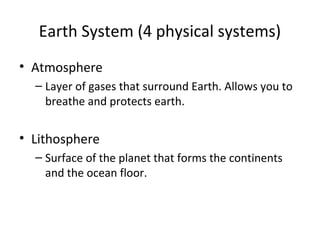Atmosphere, hydrosphere, and lithosphere (1)
- 2. Earth System (4 physical systems) • Atmosphere – Layer of gases that surround Earth. Allows you to breathe and protects earth. • Lithosphere – Surface of the planet that forms the continents and the ocean floor.
- 3. Earth System (4 physical systems) • Hydrosphere – All the water on Earth (ocean, ice, and water vapor in the atmosphere) • Biosphere – Part of Earth where life exists.
- 5. Ocean, Continents, and Atmosphere Formation • All formed because of one major source:
- 6. THE EARTH’S HYDROSPHERE • The Earth’s liquid water constitutes the hydrosphere. • The vast majority of Earth’s water is in the oceans (salt water), with smaller, but geologically important, quantities of fresh water in lakes, rivers, and ground water. • the total mass of Earth’s water is about 300 times the mass of the atmosphere. • Without water, which facilitates the formation of carbonate rock, the atmospheric content of CO2 would be far higher than it is.
- 7. Distribution of Water on Earth
- 9. Echo Sounders for Measuring Ocean Depths and Floor Profiles
- 11. Ocean Facts •The Pacific Ocean is the largest of the four main oceans •The Atlantic Ocean is the busiest. Many ships cross the Atlantic, carrying cargo between the Americas, Africa, and Europe •The Arctic Ocean is the smallest and coldest •The average temperature of all oceans is about 39 degrees F (3.8 degrees C)
- 12. •Oceans are always moving •Tides change twice a day, all over the world, as the oceans rise and fall along the shoreline. Scientists think this is caused by the pull of the sun and moon on our earth •Coral Reefs are vast, rocky areas located in shallow, tropical waters. They are like the tropical rain forest of the ocean! The greatest variety of plant and animal life in the ocean live there. Coral reefs are formed from the bodies of small sea creatures called polyps •The world's oceans contain nearly 20 million tons of gold
- 13. The World’s Ocean Floors
- 14. Production of Tsunami Waves by Earthquakes
- 15. “Black Smoker” Under-Sea Volcanic Activity • Under-sea volcanic activity gives rise to high-temperature plumes of water, containing particles of igneous rock that give rise to the appearance of black smoke. • The boiling point of water under the high pressures on the ocean floor can be considerably higher than at the surface; hence the temperatures of the volcanic plumes can be much higher as well. • It has been discovered that some species of animal life thrive on the environment of these “black smokers”, including their very high temperatures.
- 17. • Inner Core – 1200 km made of solid Fe, Ni. • Outer Core – 2250 km made of liquid Fe, Ni. • Mantle – 2900 km made of dense rocks. • Crust – 5 – 40 km made of solid lighter rocks. Lithosphere (Crust and MOHO) – 100km thick. MOHO = Mohorovicic Discontinuity
- 19. Lithosphere and the solid earth: the solid earth lies beneath the atmosphere and the oceans and composes 29% of the earth's surface. It is divided into several distinct units or layers: – lithosphere or crust: two (2) types of crust: oceanic and continental with basic differences OceanicOceanic crust is thinner, denser, and usually darker in color ContinentalContinental crust is lighter in weight, less dense, light in color, and tends to float over oceanic crust – mantle: beneath the crust; houses molten rock material called magma – outer core: composed of liquid iron and nickel; very dense material – inner core: composed of solid iron and nickel; extremely dense material
- 20. The Crust • This is where we live! • The Earth’s crust is made of: Continental Crust - thick (10-70km) - buoyant (less dense than oceanic crust) - mostly old Oceanic Crust - thin (~7 km) - dense (sinks under continental crust) - young
- 21. The seven continents: 1. Asia 2. Africa 3. North America 4. South America 5. Antarctica 6. Europe 7. Australia
Editor's Notes
- The Earth has two different types of crust: Continental crust and Oceanic crust. Each has different properties and therefore behaves in different ways. Continental crust: Continental crust forms the land (the continents, as the name suggests) that we see today. Continental crust averages about 35 km thick. Under some mountain chains, crustal thickness is approximately twice that thickness (about 70 km thick). - The mountains we see on earth have deep roots in the crust that we can’t see. The crust “floats” on the more dense mantle and, like how only the tip of an iceberg sticks up out of the water, we see only the tip of the continental crust - the mountain ranges. Continental crust is less dense and therefore more buoyant than oceanic crust Continental crust contains some of the oldest rocks on Earth. - Ancient rocks exceeding 3.5 billion years in age are found on all of Earth's continents. The oldest rocks on Earth found so far are the Acasta Gneisses in northwestern Canada near Great Slave Lake (4.03 Ga) [Ga = billion years ago] and the Isua Supracrustal rocks in West Greenland (3.7 to 3.8 Ga), but well-studied rocks nearly as old are also found in the Minnesota River Valley in the USA (3.5-3.7 billion years), in Swaziland (3.4-3.5 billion years), and in Western Australia (3.4-3.6 billion years). Oceanic crust: As the name already suggests, this crust is below the oceans. Compared to continental crust, Oceanic crust is thin (6-11 km). It is more dense than continental crust and therefore when the two types of crust meet, oceanic crust will sink underneath continental crust. The rocks of the oceanic crust are very young compared with most of the rocks of the continental crust. They are not older than 200 million years.






















